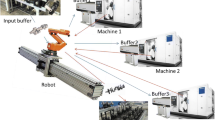Abstract
Automation is a powerful way to reduce production costs. The growing market demand for a wide set of models and small batch production make flexible automated production systems an emerging need in several industries. The aim of this paper is to analyze and to maximize the performance of robotized flexible production systems consisting of a robot, feeder, working station, and unloading station, where the operations of the working cycle are scheduled using a sequencing algorithm based on priority rules. Since the working cycle is not predefined, the cycle time is strongly influenced by the parameters characterizing the workcell such as the workcell layout, the robot transfer movements, the feeder, the working operations, and the presence of a buffer between stations. In this work, we modeled the working cycle of a simple but representative layout of an industrial robotized flexible production system with and without buffer, and we implemented a recursive algorithm to estimate the cycle time. The analytical model derived was compared to the experimental results, obtained by using a prototype of the flexible production workcell. The results show that the analytical model is a powerful tool to estimate the performance of the workcell and to identify the design variables or their combinations that maximize the throughput.
Similar content being viewed by others
References
Wolfson W, Gordon SJ (1997) Designing a parts feeding system for maximum flexibility. Assem Autom 17(2):116–121
Reinhart G, Loy M (2010) Design of a modular feeder for optimal operating performance. CIRP J Manuf Sci Technol 3:191–5
Heilala J, Montonen J, Vaatainen O (2008) Life cycle and unit-cost analysis for modular reconfigurable flexible light assembly systems. J Eng Manuf 222(10):1289–99
Manzini R, Gamberi M, Regattieri A, Persona A (2004) Framework for designing a flexible cellular assembly system. Int J Protein Res 42(17):3505–28
Battini D, Faccio M, Ferrari E, Persona A, Sgarbossa F (2007) Design configuration for a mixedmodel assembly system in case of low product demand. Int J Adv Manuf Technol 34:188–200
Tay ML, Chua PSK, Sim SK, Gao Y (2005) Development of a flexible and programmable parts feeding system. Int J Prod Econ 98:227–37
Battini D, Faccio M, Persona A, Regattieri A (2013) Buffer design for availability: a new simulative study in case of infant and random failures. International Journal of Services and Operations Management 14(2):157–174
Rosati G, Faccio M, Carli A, Rossi A (2013) Fully flexible assembly systems (F-FAS): a new concept in flexible automation. Assem Autom 33(1):8–21
Rosati G, Faccio M, Finetto C, Carli A (2013) Modelling and optimization of fully flexible assembly systems (F-FAS). Assem Autom 33(2):165–174
Finetto C, Rosati G, Faccio M, Rossi A (2015) Implementation framework for a fully flexible assembly system (F-FAS). Assem Autom 35(1):114–121
Finetto C, Faccio M, Rosati G, Rossi A (2014) Mixed-model sequencing optimization for an automated single-station fully flexible assembly system (F-FAS). Int J Adv Manuf Technol 70(5–8):797–812
Fradrich T, Pachow-Frauenhofer J, Torsten F, Nyhuis P (2011) Aerodynamic feeding systems: an example for changeable technology. Assem Autom 31(1):47–52
Zhou B, Yu J, Shao J, Trentesaux D (2015) Bottleneck-based opportunistic maintenance model for series production systems. J Qual Maint Eng 21(1):70–88
Kose SY, Kilincci O (2015) Hybrid approach for buffer allocation in open serial production lines. Comput Oper Res 60:67– 78
Vidalis MI, Papadopoulos CT, Heavey C (2005) On the workload and phase load allocation problems of short reliable production line with finite buffers. Comput Ind Eng 48(4):825837
Aksoy HK, Gupta SM (2005) Buffer allocation plan for remanufacturing cell. Comput Ind Eng 48(3):657677
Benedetti M, Cesarotti V, Giuiusa A, Introna V (2014) Buffer size design in pharmaceutical packaging lines: an analytical methodology proposal and case study. Source of the Document International Journal of Engineering Business Management 6(1):1–10
Senanayake CD, Subramaniam V (2013) Analysis of a two-stage, flexible production system with unreliable machines, finite buffers and non-negligible setups. Flex Serv Manuf J 25(3):414–442
Zequeira RI, Valdes JE, Berenguer C (2008) Optimal buffer inventory and opportunistic preventive maintenance under random production capacity availability. Int J Prod Econ 111(2):686696
Buzacott JA (1967) Automatic transfer lines with buffer stocks. Int J Prod Res 5(3):183200
Diamantidis AC, Papadopoulos CT, Heavey C (2007) Approximate analysis of serial flow lines with multiple parallel machine stations. IIE Trans 39(4):361375
Azzi A, Battini D, Faccio M, Persona A (2012) Sequencing procedure for balancing the workloads variations in case of mixed model assembly system with multiple secondary feeder lines. Int J Prod Res 50(21):60816098
Battini D, Faccio M, Persona A, Sgarbossa F (2009) Balancings equencing for a mixed model assembly system in case of finite buffer capacity. J Adv Manuf Technol 44(34):345359
Edmondson NF, Redford AH (2002) Generic flexible assembly system design. Assem Autom 22(2):139–152
Siciliano B, Sciavicco L, Villani L, Oriolo G (2009) Robotics modelling, planning and control. Springer, London, pp 161– 189
Drobouchevitch IG, Geismar HN, Sriskandarajah C (2010) Throughput optimization in robotic cells with input and output machine buffers: a comparative study of two key models. Eur J Oper Res 206:622–633
Dawande M, Geismar H, Sethi S, Sriskandarajah C (2005) Sequencing and scheduling in robotic cells: recent developments. J Sched 8:387–426
Abd K, Abhary K, Marian R (2001) A scheduling framework for robotic flexible assembly cells. International Journal of Applied Science and Technology 4(1):31–38
Abd K, Abharya K, Mariana R (2012) Efficient scheduling rule for robotic flexible assembly cells based on fuzzy approach. In: Proceedings of the 45th CIRP conference on manufacturing systems, pp 483–488
Author information
Authors and Affiliations
Corresponding author
Rights and permissions
About this article
Cite this article
Rosati, G., Oscari, F., Barbazza, L. et al. Throughput maximization and buffer design of robotized flexible production systems with feeder renewals and priority rules. Int J Adv Manuf Technol 85, 891–907 (2016). https://doi.org/10.1007/s00170-015-7995-0
Received:
Accepted:
Published:
Issue Date:
DOI: https://doi.org/10.1007/s00170-015-7995-0



